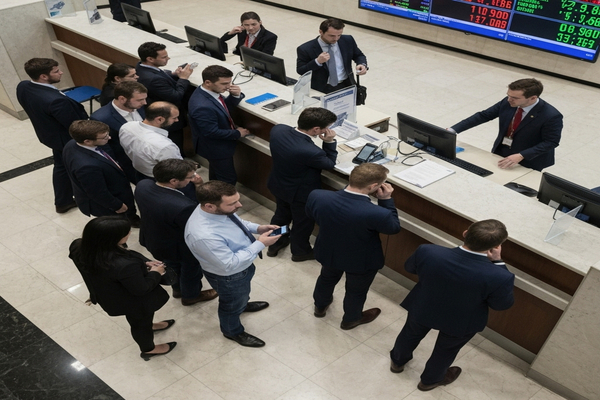
Bank stress, gold surge and a softer dollar set the opening tone for traders
Global markets open under pressure from U.S. bank stock weakness while gold rallies and the dollar slides. Short-term action is driven by fresh regional bank announcements, recent auto sector bankruptcies, and renewed bets on Federal Reserve easing. Gold is accelerating higher and is on course for its best week in 17 years, while oil markets wrestle with forecasts of a supply glut and questions about the whereabouts of almost 1.5 million barrels per day of crude. The developments matter now because Fed expectations, geopolitical moves and energy disruptions can all reshape risk pricing this week in the United States, Europe, Asia and emerging markets.
Bank stocks and credit anxiety
Regional shocks tighten risk appetite and test lending channels
U.S. bank shares are under pressure after negative announcements from two regional lenders. Traders are sorting through fresh signs of credit stress at small and mid sized institutions and what those signs mean for broader funding conditions. Auto sector bankruptcies have added to the worry set. They highlight consumer and corporate stress in a credit sensitive part of the economy.
Short-term, this dynamic is weighing on risk assets and is feeding demand for safe havens. Markets are pricing increased sensitivity to any sign that losses could spread through the banking system. Meanwhile, expectations for more Federal Reserve easing this year have become an offsetting force. A weaker dollar and looser implied policy leaves room for higher asset prices in some pockets.
Over the longer term, persistent credit strain would raise questions about lending standards, capital cushions and the cost of credit for households and companies. That would matter differently across markets. In the United States, tighter credit could slow consumption and investment. In Europe and Asia, weaker global demand would transmit through trade channels and corporate earnings.
Gold’s rally and the safe haven premium
Strong flows, weak dollar and the digital gold conversation
Gold is racing higher and surpassed $4,300 per ounce early on Friday. The metal is on track for its best weekly performance in 17 years. Traders point to a mix of factors. A softer dollar is lowering the opportunity cost of holding bullion. Risk aversion from bank and corporate credit headlines is pushing demand for traditional safe havens. Expectations of weaker policy settings in the United States are also supporting prices.
In addition, a debate over the role of physical gold versus digital assets is resurfacing. A recent industry report framed the discussion around whether traditional bullion or tokenised versions of gold will capture investor interest. That debate has practical implications. If demand shifts from paper to physical or to tokenised forms, market structure, storage and liquidity dynamics could change.
For global investors, the immediate importance is clear. A rapid and sustained rise in gold can influence portfolio rebalancing decisions, hedging strategies and flows into related instruments. Over time, cultural and technological shifts in how investors access gold could matter for central bank reserves, private holdings and commodity markets in Asia, Europe and the United States.
Oil markets: supply glut forecasts meet missing barrels
Analysts see weaker prices next year, but missing crude keeps risk alive
Oil prices look set to fall for the week as the market prices in a possible supply surplus next year. Forecasts that global inventories will rise have put downward pressure on futures. However, attention is focused on reports that the whereabouts of almost 1.5 million barrels per day of crude are uncertain. That unknown quantity adds a layer of volatility to the outlook.
Complicating this picture are renewed military actions and diplomatic activity linked to the war in Ukraine. Recent strikes on energy infrastructure inside Ukraine and in Russian regions have signalled a potential escalation of supply risk. In parallel, leaders in Washington and Moscow have agreed to meet for another summit in Budapest. That meeting could influence narratives about ceasefire prospects and energy flows even if a quick resolution remains unlikely.
For Europe, the recent operational shocks are a reminder of vulnerability in energy systems. Countries that rely heavily on imported fuels are closely watching how disruptions and diplomatic moves affect storage and winter preparedness. In Asia and emerging markets, lower oil prices would ease import bills but could hit revenue for commodity exporters.
Structural themes: AI valuations, renewables and raw material controls
Valuation questions, policy rollbacks and the politics of critical minerals
Beyond immediate market moves, several structural themes are shaping investor attention. Valuations for AI related companies are once again under scrutiny. Conversations about whether high multiples represent speculative excess or a justified premium for innovation are recurring in podcasts and market forums. Those debates influence sentiment in technology sectors and in broader equity markets.
Renewable energy names have performed strongly this year even as some policy support was pared back in the United States. Clean energy stocks continue to attract flows on expectations of long term demand growth. Research from industry consultancies lays out scenarios for how the energy transition could play out over the coming decades. That research is informing allocation decisions across regions.
At the same time, a spat over export controls on rare earths and other critical minerals has raised supply chain concerns. Policymakers and firms are reassessing sourcing strategies. Energy transition technologies depend on a steady supply of specialized metals. If export curbs become more widespread, companies will need to weigh alternative suppliers and invest in recycling or domestic capacity. These are practical steps that will take time and capital to implement.
What to watch in the session ahead includes new economic data that could shift Fed policy expectations, updates from regional banks, and inventory or production notices that affect oil and precious metals. Geopolitical headlines and corporate filings in credit sensitive sectors will also be monitored closely. For traders and portfolio managers, the immediate challenge is balancing shorter term credit and policy signals against longer term structural trends in energy, technology and commodity supply chains.












